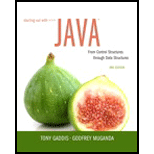
Explanation of Solution
Method definition for “removeMin()”:
The method definition for “removeMin()” is given below:
/* Method definition for "removeMin()" */
String removeMin()
{
/* If the list head is null, then */
if (first == null)
//Returns null
return null;
/* Set minimum string to "first" node */
Node minimumString = first;
/* Set minimum string predecessor to list head*/
Node minimumPred = first;
/* Set reference node to next node of list head */
Node refNode = first.next;
/* Set the reference of predecessor node */
Node refPred = first;
/* If the reference node "refNode" is not "null", then */
while (refNode != null)
{
/* Check condition */
if (refNode.value.compareTo(minimumString.value) < 0)
{
/* Assign minimum string to "refNode" */
minimumString = refNode;
/* Set minimum predecessor to reference of predecessor */
minimumPred = refPred;
}
/* Set "refPred" to "refNode*/
refPred = refNode;
/* Set "refNode" to next reference node */
refNode = refNode.next;
}
// Compute If the first node is the minimum or not
String resultantString = minimumString.value;
/* If the minimum string is list head, then */
if (minimumString == first)
{
//Remove the first string
first = first.next;
/* If the list head is "null", then */
if (first == null)
/* Set "last" to "null" */
last = null;
}
//Otherwise
else
{
//Remove an element with a predecessor
minimumPred.next = minimumString.next;
// If the last item removed, then
if (minimumPred.next == null)
/* Assign "last" to "minimumPred" */
last = minimumPred;
}
/* Finally returns the resultant string elements */
return resultantString;
}
Explanation:
The above method definition is used to remove a minimum element from a list.
- If the list head is null, then returns null.
- Set minimum string and minimum predecessor to “first” node.
- Set reference node to next node of list head and also set the reference of predecessor node.
- Performs “while” loop. This loop will perform up to the “refNode” becomes “null”.
- Check condition using “if” loop.
- If the given condition is true, then assign minimum string to “refNode”.
- Set minimum predecessor to reference of predecessor.
- Set “refPred” to “refNode”.
- Set “refNode” to next reference node.
- Check condition using “if” loop.
- Compute if the first node is minimum or not.
- If the minimum string is list head, then
- Remove the first string.
- If the list head is “null”, then set “last” to “null”.
- Otherwise,
- Remove an element with a predecessor.
- If the last item removed, then assign “last” to “minimumPred”.
- Finally returns the resultant string elements.
Complete code:
The complete executable code for remove a minimum string element from a linked list is given below:
//Define "LinkedList1" class
class LinkedList1
{
/** The code for this part is same as the textbook of "LinkedList1" class */
/* Method definition for "removeMin()" */
String removeMin()
{
/* If the list head is null, then */
if (first == null)
//Returns null
return null;
/* Set minimum string to "first" node */
Node minimumString = first;
/* Set minimum string predecessor to list head*/
Node minimumPred = first;
/* Set reference node to next node of list head */
Node refNode = first...
Want to see the full answer?
Check out a sample textbook solution
Chapter 20 Solutions
Starting Out with Java: From Control Structures through Data Structures (3rd Edition)
- List down the strenghts and weaknesses of your team project for Capsim Simulation? Explan.arrow_forwardCapsim Team PowerPoint Presentations - Slide Title: Key LearningsWhat were the key learnings that you discovered as a team through your Capsim simulation?arrow_forwardWrite the SQL code that permits to implement the tables: Student and Transcript. NB: Add the constraints on the attributes – keys and other.arrow_forward
- Draw an ERD that will involve the entity types: Professor, Student, Department and Course. Be sure to add relationship types, key attributes, attributes and multiplicity on the ERD.arrow_forwardDraw an ERD that represents a book in a library system. Be sure to add relationship types, key attributes, attributes and multiplicity on the ERD.arrow_forward2:21 m Ο 21% AlmaNet WE ARE HIRING Experienced Freshers Salesforce Platform Developer APPLY NOW SEND YOUR CV: Email: hr.almanet@gmail.com Contact: +91 6264643660 Visit: www.almanet.in Locations: India, USA, UK, Vietnam (Remote & Hybrid Options Available)arrow_forward
- Provide a detailed explanation of the architecture on the diagramarrow_forwardhello please explain the architecture in the diagram below. thanks youarrow_forwardComplete the JavaScript function addPixels () to calculate the sum of pixelAmount and the given element's cssProperty value, and return the new "px" value. Ex: If helloElem's width is 150px, then calling addPixels (hello Elem, "width", 50) should return 150px + 50px = "200px". SHOW EXPECTED HTML JavaScript 1 function addPixels (element, cssProperty, pixelAmount) { 2 3 /* Your solution goes here *1 4 } 5 6 const helloElem = document.querySelector("# helloMessage"); 7 const newVal = addPixels (helloElem, "width", 50); 8 helloElem.style.setProperty("width", newVal); [arrow_forward
 EBK JAVA PROGRAMMINGComputer ScienceISBN:9781337671385Author:FARRELLPublisher:CENGAGE LEARNING - CONSIGNMENT
EBK JAVA PROGRAMMINGComputer ScienceISBN:9781337671385Author:FARRELLPublisher:CENGAGE LEARNING - CONSIGNMENT C++ Programming: From Problem Analysis to Program...Computer ScienceISBN:9781337102087Author:D. S. MalikPublisher:Cengage Learning
C++ Programming: From Problem Analysis to Program...Computer ScienceISBN:9781337102087Author:D. S. MalikPublisher:Cengage Learning New Perspectives on HTML5, CSS3, and JavaScriptComputer ScienceISBN:9781305503922Author:Patrick M. CareyPublisher:Cengage Learning
New Perspectives on HTML5, CSS3, and JavaScriptComputer ScienceISBN:9781305503922Author:Patrick M. CareyPublisher:Cengage Learning Microsoft Visual C#Computer ScienceISBN:9781337102100Author:Joyce, Farrell.Publisher:Cengage Learning,Programming Logic & Design ComprehensiveComputer ScienceISBN:9781337669405Author:FARRELLPublisher:Cengage
Microsoft Visual C#Computer ScienceISBN:9781337102100Author:Joyce, Farrell.Publisher:Cengage Learning,Programming Logic & Design ComprehensiveComputer ScienceISBN:9781337669405Author:FARRELLPublisher:Cengage Systems ArchitectureComputer ScienceISBN:9781305080195Author:Stephen D. BurdPublisher:Cengage Learning
Systems ArchitectureComputer ScienceISBN:9781305080195Author:Stephen D. BurdPublisher:Cengage Learning





